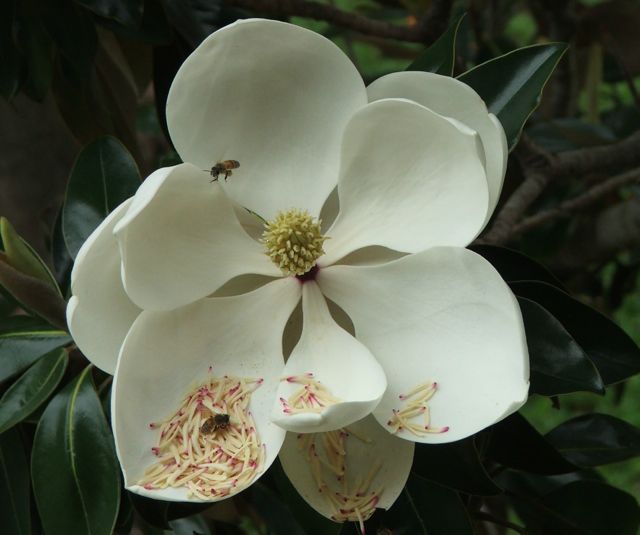Our native Southern Magnolia, symbol of the South and the state flower of Mississippi and Louisiana, is now showing large fragrant white flowers. Its botanical name Magnolia grandiflora refers to its bloom size.
The Magnolia family has over 200 species and is one of our earth’s oldest flowering plant families, with some fossil records dating back 90 or more million years. The flower especially demonstrates this ancient history. Modern flowers have reduced numbers of female parts (pistils), usually just one, whereas more primitive ancestral flowers have several to many. Magnolia flowers apparently developed before bees, and their sturdy female structures are designed for pollination by beetles. Female pistils, curved cream colored, are surrounded by male stamens with red bases, some of which detach and collect into petals.

Southern Magnolia flowers do not produce nectar, but bees are attracted by fragrance and for abundant pollen.

Interesting is that another member of the Magnolia family, Tuliptree Magnolia, also called Tulip Poplar, has smaller greenish-yellow flowers with lots of nectar that is great for honeybees!

As Southern Magnolia flowers age, petals and pollen-producing stamens drop, leaving female pistils to develop into fruits. Each cone-like fruit is actually a cluster of many individual one-seeded fruits that developed from the flower’s female pistils. These cones turn shades of pink just before shedding seeds in fall. Seeds are bright red and provide food for birds and small mammals, and are considered non-toxic for pets. Cone-like fruits finally turn brown and drop to the ground.


In winter, evergreen Southern Magnolias are even more easily spotted along roads and in yards, when other trees have lost their leaves. Majestic Magnolias are most beautiful when allowed to keep lower limbs that reach down to the ground. An example is the one growing in Due West at the home of Bill and Emilie Lesesne that is beautifully dressed in a full-length skirt!

Sadly, Magnolias often get “limbed up”, stripping them of their natural glorious green “skirts”!
Horticulture has developed several Magnolia cultivars including the following:
- “Bracken’s Brown Beauty”, developed by Ray Bracken of Easley, South Carolina. It is a smaller and more compact tree that can withstand colder climates.
- “Little Gem”, considered a “dwarf” cultivar, with a column shape, and growing to about 14 feet blooming with many cup-shaped flowers.
